Introduction :
Electric current is one of the most valuable inventions that humankind ever invented. But what exactly is meant by an electric current? What is happening in the sub-atomic particles? In simple terms, we all know that the movement of electrons is called an electric current. Electrons always move inside an atom. Will all the movements of electrons constitute the electric current? We will try to figure out the answers to all these questions in this post. Hope, it will clear all your doubts regarding the electric current by making you understand some of the basic things about electric current.
Definition of Electric current :
The textbook definition of electric current is,
The uniform net movement of charge carriers per unit time, while they are moving through a cross-sectional area of an electrical conductor (or) space is known as electric current.
In simple words, whenever the charge carriers move uniformly inside a material, that phenomenon is called electric current.
S.I. unit of the current is “ampere” (A).
What is meant by ampere (A)?
The S.I. unit of current is the “ampere” (A), which is named for the French scientist “André-Marie Ampère” (1775–1836). In written languages without accented letters (namely English) it has become customary to write the unit as “ampere” and, in informal communication, to shorten the word to “amp”. I have no problem with either of these spellings. Just don’t use the capital “A” at the beginning. “Ampere” refers to a “physicist”, while “ampere” (or) “amp” refers to a “S.I. unit”.
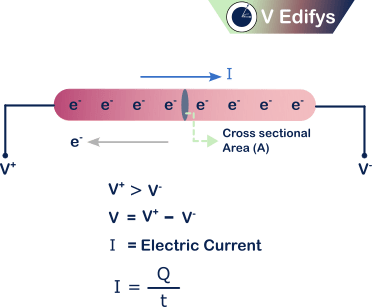
What is meant by charge carriers?
A particle which holds some sort of electric charge ( i.e. positive charge (or) negative charge ) is called a charge carrier
Ex :
- Sub-atomic particles like electrons and protons
- Ions ( whenever an atom loses (or) gains an electron )
- Positive ion = An atom losses an electron
- Negative ion = An atom gains an electron
- Holes = ( absence of an electron, think of it as a positive charge )
Well, these few lines of definition won’t provide the proper picture regarding the electric current. Even when I first read this definition, I couldn’t understand the full picture of electric current. So, we will dive deep into the sub atomic level of an atom to clearly understand the electric current, then we will return to this definition.
Basic Atomic structure :
We know that every element in our universe is made up of atoms. Likewise, every atom contains subatomic particles like electrons, protons, neutrons etc.,
We all know that the nucleus is the center of every atom. The atomic nucleus consists of sub-atomic particles like neutrons and protons. In every atom, there is an equal number of protons and electrons, that’s why the atoms are always electrically neutral. Neutrons are neutral, it doesn’t have any electrical charge particles which is why they are called neutrons.
- The electrons are negatively charged particles
- The protons are positively charged particles
In all the atoms, the nucleus is surrounded by the electron cloud. Let’s consider the “NIELS BOHR’s” atomic model, in which electrons circle the nucleus in distinct energy levels. The path in which the electrons are circled is known as an electron shell. The outermost electron shell (or) energy level is called the valence shell. Electrons in the valence shell are called valence electrons. These valence electrons tend to free themselves from the atom to act as free electrons. These free electrons aren’t influenced by any attractive force from their atomic nucleus anymore, so they move randomly inside the material.
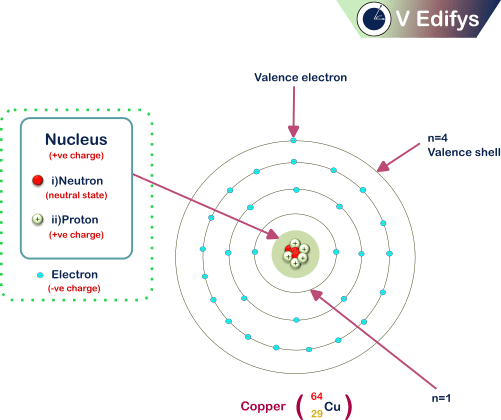
Here a copper atom is given. It has 29 electrons and 29 protons, so its Atomic Number is 29. It has 35 neutrons, therefore its Mass Number is 64.
Atomic Number = Total number of electrons (or) Total number of protons
Mass Number = Arithmetic sum of Total number of electrons (or) protons + Total number of neutrons
How to decide how many electrons are present in an atomic shell?
There is a formula to decide, the number of electrons present in a shell.
Formula :
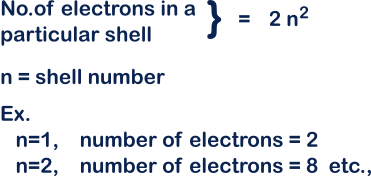
The atomic shell must be either completely filled (or) completely empty. If that is not the case the electrons in the partially filled shell, tend to move away from that shell. In that, process the electron may end up breaking its attractive bond with the nucleus and make itself as a free electron.
Here in our case, the copper atom has a partially filled valence shell ( n=4 ). So, the electron in that valence shell tends to break its attractive bond with the atomic nucleus.
How an electron breaks its bond with the nucleus:
Electrons are attached to their nucleus with the attractive force between electrons and protons. Because the same electric charges repel each other and different electric charges attract each other. But electrons in the partially filled shells always try to break from this attractive bond, whenever possible. When electrons acquire the required energy to break this bond they will move freely inside the material. Electrons may get this energy, from surrounding temperature, by absorbing light energy (or) by some other chemical methods.
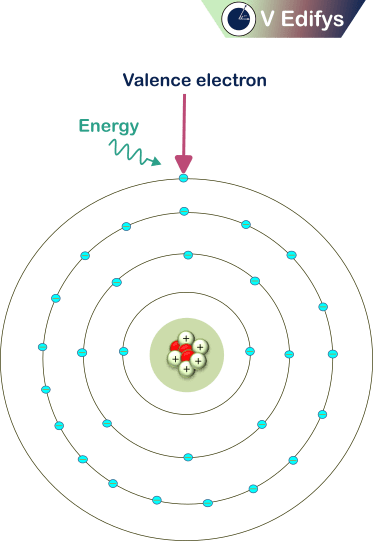
In conducting materials, at room temperature, the electron gains the required energy to break the bond and free itself. This is why conducting materials have a lot of free electrons at room temperature, this phenomenon made the conducting materials superior for electrical conductivity.
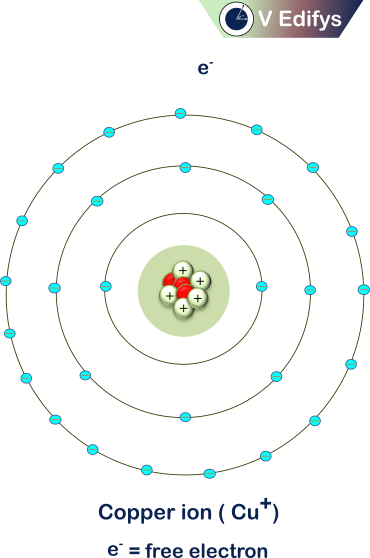
What makes the electric current?
By now you may have a question, electrons, in every atom circularly move around its nucleus. Does this electron movement constitute current? The answer is no, because we have already seen that the net movement of the charge carriers in a uniform direction constitutes electric current. Here in every atom, the electron is cycling around its nucleus in a random direction, so it doesn’t constitute electric current. One more thing is the electric current is only created when the free-charge carriers are moving. Here the electron is still attached to its nucleus, so this movement of the electron doesn’t constitute anything to electric current.
The free electrons break their bond with the nucleus with the help of energy absorption and make them free from the nucleus’s attractive force, and it’s now get the freedom to travel freely inside the material. Does the movement of this free electron constitute an electric current? No, all these free electrons are moving in a random direction, therefore the net movement of an electron will become zero, therefore no electric current.
What do we need to do to make an electric current? Yes, what you think is correct, we need to convert the random movements of free electrons into a uniform movement. For that, we need to keep the two ends of the material in a different electric potential. For this purpose, we attach a voltage source across a material, this will create an electric potential difference between the two ends of the material. Now all free electrons are moving towards the higher electrical potential side of the material (i.e. positive electric potential) because opposite charges attract each other.

Conventional current (or) Conventional current direction :
You may have heard about the conventional current, What does it mean by that? Is it another type of current? well, the answer is that it’s just a representation of direction for the actual electric current. It is mainly known as the conventional current direction.
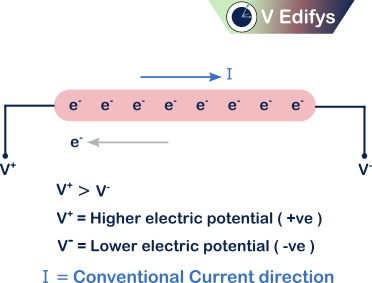
Now you know, what constitutes the current, in an electrical system. We already know that the net movement of free electrons in a uniform direction is known as electric current, but why we are representing the electric current direction in opposition to the moving direction of free electrons? Well, in the early days, it was believed that positive charges were responsible for electric current ( back then electrons hadn’t been discovered ). This is why the electric current direction is denoted in the opposite direction of the flow of an electron (or) in the same direction of the flow of positive charge. Later, it was found out that the electrons are the reason for Electric current, by then the electric current direction is mentioned as the opposite direction to the flow of electrons all over the physics. So, we followed this convention for the electric current direction.
Classification of electric current :
Electric current is classified into two different types.
- Direct Current (DC)
- Alternating Current (AC)
1. Direct Current (DC)
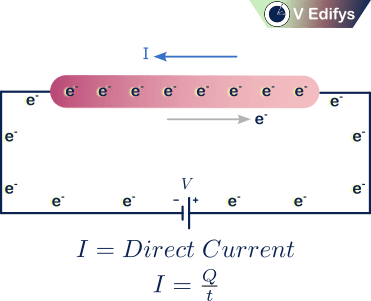
If the electric charge carrier’s (i.e. electrons) net movement is uniformly in the same direction then this uniform movement of electrons constitutes Direct Current (DC). Here the electrons, don’t change their travelling direction after some time.
Plotting Direct Current (DC) :
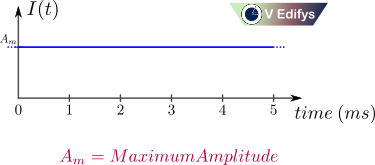
Here the amplitude of the electric current won’t change with time. Here the amplitude of electric current is constant throughout the time. What it indirectly tells us is that the electrons won’t change their moving direction inside the material.
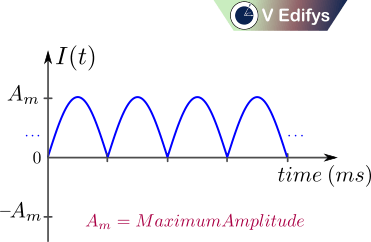
What do you think about this graph? Here the electric current changes its amplitude over time. Do you think it is an Alternating Current? No, this is not an Alternating Current, because the electrons still moving uniformly in the same direction, they won’t change their moving direction. Here the electric current amplitude is varying, it doesn’t do anything with the electrons moving direction. Still, if you are confused, then read the following sections.
2. Alternating Current (AC)
If the electric charge carrier’s (i.e. electrons) net movement is uniform in the forward direction for a specific time, then its net movement is uniform in the opposite direction for the same amount of time. If this process happens continuously, then this action constitutes a current called Alternating Current (AC).
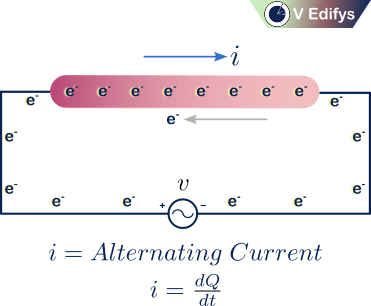
Alternating Current means, that current changes its direction continuously once in a specific amount of time.
Let’s look at an example,
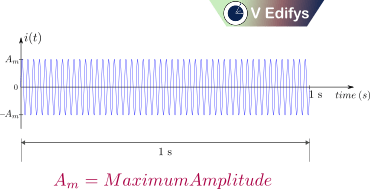
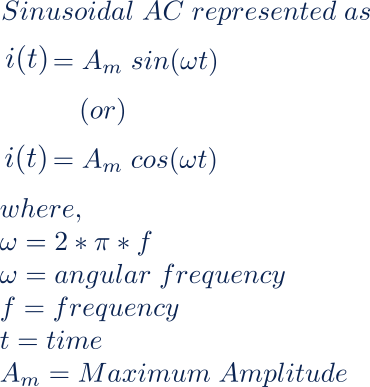
Most countries are using 50 Hz AC supply, In India, we are using 50 Hz AC, which means the electrons are moving 50 times back and forth. Some countries are also using 60 Hz AC supply, In the US, Canada and some other parts of the world are using 60 Hz AC, which means the electrons are moving 60 times back and forth.
Here, you may have a doubt, How to determine, how long the electrons are moving in the forward direction and backward direction? To answer this question first we need to understand some basics about Frequency (f) and Fundamental Time period (T).
Frequency (f) :
In simple words, “The Total number of cycles per second” is the simple definition of frequency. In plain English, frequency means how many times the same action happens over a particular period of time. What is meant by cycle here? In AC the electrons are moving in the forward direction for some time, then change their traveling direction to the backward direction for the same amount of time. Vice-versa is also true. After that, this same process continued again. Here one cycle means the one complete movement of electrons in both forward and backward directions.
The S.I. Unit of the Frequency is “hertz” (Hz)
Fundamental Time Period (T) :
The time taken to complete one cycle is called the Fundamental Time Period (T).
The S.I. Unit of the Fundamental Time Period is “seconds” (s).
There is a relationship between the Frequency (f) and Fundamental Time Period (T).
i.e.
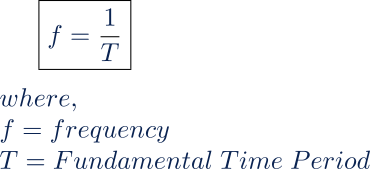
In the case of 50 Hz AC,
T = 20 ms, which means electrons are moving in the forward direction for 10 ms and in the backward direction for 10 ms.
Plotting of Alternating Current (AC) :

This looks too complex, right? Let’s do one thing, zoom the graph to look it closer. Here I only take one complete cycle of electric current.
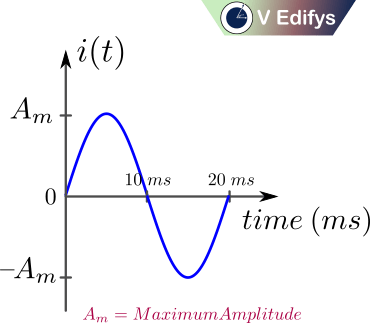
Here let’s consider the amplitude of electric current follows sinusoidal form. I am mathematically representing the AC in the sine format, i.e.  . Sine format is widely used to represent the AC.
. Sine format is widely used to represent the AC.
Here I take the electric current graph up to time period T=20 ms. How I am saying this particular graph is an Alternating Current graph? Here the amplitude of electric current varies over time and the electrons are changing its moving direction forward and backward. I am denoting this phenomenon by plotting the graph above and below the X-Axis respectively. In the case of DC, the amplitude changes with time, but it never crosses the X-Axis which means the electrons are moving in the same direction all the time.
Case (i) :

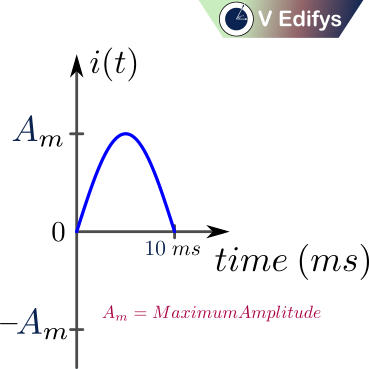
Here I am representing the amplitude of electric current as positive (+) in the time period of 0 ms to 10 ms. Am represents the maximum amplitude, during this time period the amplitude of the electric current varies with the time. During this time interval, the AC is called positive half-cycle AC.
Case (ii) :
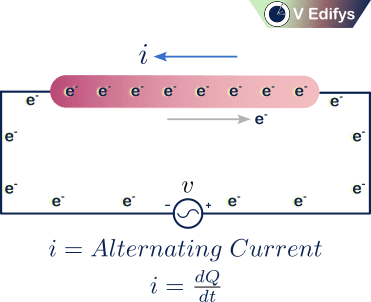
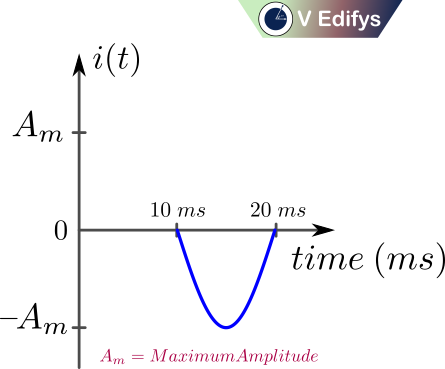
Here I am representing the amplitude of electric current as negative (-) in the time period of 10 ms to 20 ms. -Am represents the maximum amplitude, during this time period the amplitude of the electric current varies with the time. During this time interval, the AC is called negative half-cycle AC. Have you ever wondered, how the electric current be negative (-)? Do you ever measure an electric current as -5 A? For me, the answer is, no. I may have some situation in the circuit analysis to represent the electric current as -5A, but I never measured the electric current quantity as negative. What about you? In general, there is no negative (-5 A) electric current, but why do we use this notation to represent current?
A negative sign (-) doesn’t do anything, with the absolute value of the amplitude of the electric current. It is just the way to represent the electric current direction. If the positive sign (+) is used for representing the electric current in the forward direction, then the negative sign (-) is used for representing the electric current in the backward direction. The positive (+) and negative (-) signs don’t tell us the absolute value of the amplitude of the electric current. These are tools to represent the electron’s moving direction.
The following are also a few examples of Alternating Current (AC)
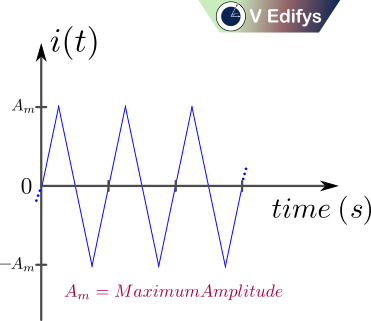

Hereafter wherever you see an electric current amplitude graph with both positive (+) and negative (-) amplitudes then remember that graph belongs to the Alternating Current (AC).
Summary :
1. Now, you can understand electric current by its definition,
Proper textbook definition :
“The uniform net movement of charge carriers per unit time, while they are moving through a cross-sectional area of an electrical conductor (or) space is known as electric current.”
Electric current is represented as “I” and its S.I. unit is “ampere” (A).
Another S.I unit of Electric current is C/s (or) C s-1.
2. There are two types of current
- Direct Current (DC)
- Alternating Current (AC)
3. The negative sign in the electric current amplitude doesn’t tell us, its absolute value. It deals with the direction in which the electric current flows.

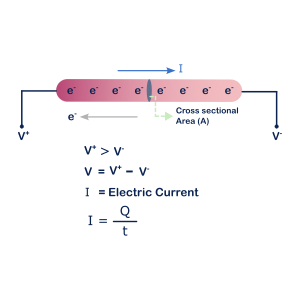

One Response
This is quality work regarding the topic! I guess I’ll have to bookmark this page. I hope it gets your seal of approval, too!